How to improve dexterity and the best fine motor toys for toddlers
Is your toddler struggling with fine motor skills? Do you want to improve your toddler’s hand strength?
Fine motor skills are important for kids to help them be able to do things like write or tie their shoes.
My son has always had developmental delays since day 1. As a result of his traumatic birth and surviving the NICU, he’s had therapies for 3+ years. We’ve learned how to identify weak fine motor and ways to strengthen them through weekly occupational therapies.
In this blog post, I’ll share some easy and fun fine motor toddler activities you can do at home.
This post may contain affiliate links, which means I’ll receive a commission if you purchase through my link, at no extra cost to you. Please read full disclosure here.
Why is fine motor skills important?
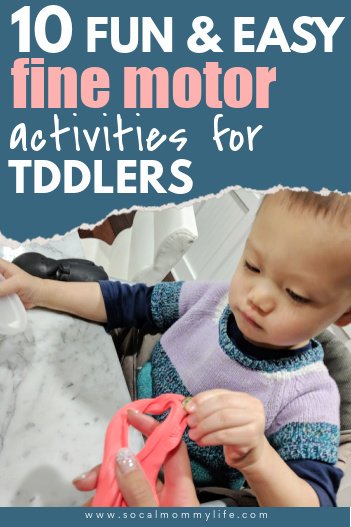
Fine motor skills involve the movement of the fingers, hands, and wrists. Developing these skills will help kids in school, sports, and life.
Fine motor skills are especially crucial because the ability to use smaller muscles in the hands, or dexterity, allows children to perform self-care tasks, without assistance. This includes:
- getting dressed (securing buttons, tie shoe laces, put on zipper, etc.)
- brushing their teeth
- eating
- writing
- coloring
Also, studies have shown that activities that encourage fine motor abilities and hand-eye coordination are a lot better than purely intellectual activities—memorization of letters and numbers. When combined with increasing hand-eye coordination, fine motor skills also open new doors to exploration, learning, and creative expression (1).
Fine motor developmental milestone
Fine motor skills usually develop naturally as your child gains the ability to control and coordinate their body. Keep in mind that every child develops at their own pace.
Here’re some major fine motor milestones for babies and toddlers you should be observing (2):
0 to 3 months
- tightly grasp object when placed in both hands
- attemp to reach for an object
3 to 6 months
- reach and grasp a small toy using both hands
- moves a toy from one hand to the other
6 to 9 months
- can poke object with index finger
9 to 12 months
- grabs small objects with thumb and index finger (pincer grasp)
- place small objects in a container
12 to 18 months
- Removes or dumps out objects from a container
- Begins to make small marks on a paper
18 months to 2 years
- turns a doorknob
- uses a spoon and fork correctly
- strings beads on yarn
2 to 3 years
- able to unscrew a container
- copies a circle on paper
- snips paper with child‐safe scissors
What causes fine motor delay in toddler
Researchers don’t always know what causes these fine motor problems, but some possibilities include:
- Premature birth, which can cause muscles to develop more slowly
- Genetic disorders
- Developmental problems such as autism
- Decreased finger, arm, and core strength
- Cognitive delays
- Vision problems
Don’t jump to a conclusion if your child has fine motor delays. Some children reach their fine motor milestones later, and that’s not a problem at all.
More often than not, fine motor delays in toddlers are caused by the lack of opportunity to use them. The best way to improve fine motor skills for toddlers is by providing them with plenty of opportunities to do so.
Are you ready for some ideas on fine motor toddler activities? Keep reading!
10 Fine Motor Toddler Activities You Can Do at Home
Playing With Putty
Putty clays are soft, bouncy, and squishy for comfortable sculpting and stretching. It has a similar texture to Playdough but is not messy and can dry out like its squishy counterpart.
Hide small objects like buttons and gems in the putty. Encourage your toddler to squeeze and pinch out the small object.
This is a great exercise to practice that pincer grasp. You can ask your toddler to use his index finder to retrieve objects and pushing the objects into the putty.
We love TheraPutty because it has different levels of resistance to choose from. TheraPutty is widely used by therapists.
The red soft level is best for a toddler because it’s soft enough for the small hand but offers the perfect resistance.
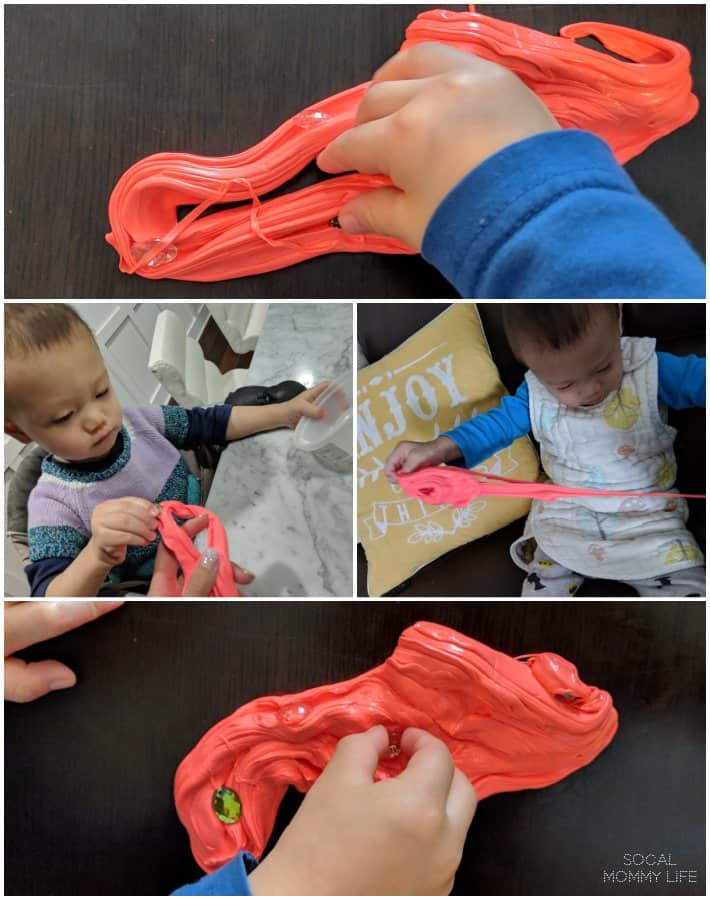
Playing With Playdough
Playdough is a fun, hands-on toy that can help with fine motor development. There are many different ways to play and explore the benefits of this classic tool!
Here are some fun ways to get hands-on with playdough:
- roll playgough in a ball with both palms
- squeeze playdough with both hands
- press down playdough on the table
- make a hole with index fingers
- roll playdough on the table to make a snake
- hide small objects like character erasers and have your toddler pinch them out
What I love about playdough is that it comes in a variety of sets. From pasta makers to construction sites, there are plenty of creative and fun kits your toddler will like.
We have many playdough sets and I highly recommend the cookie creations set for fine motor skills development. You can spend quality time with your toddler and make some fun decorations for the kitchen! Your little one will love using this set to roll out cookie dough. Get creative by pushing playdough into different molds or use it as a shape cutter.
![]() Check out these fine motor toys for toddlers parents love
Check out these fine motor toys for toddlers parents love
Psst.. all of these toys are under $20!
Play with puzzles
Puzzles are a fantastic way to improve fine motor skills and hand-eye coordination. It also provides a fun and engaging activity that help with problem-solving, creativity, and spatial awareness.
A child can become frustrated if he can’t put the puzzles together. Help him by completing most of the pieces and leave the last pieces for him to complete. Next time you play the same puzzle, leave more pieces for your child to complete. Eventually, he’ll be able to do the puzzles all by himself.
This is how we trained Baby Will. At age 2 he was able to play with puzzles for ages 5+!
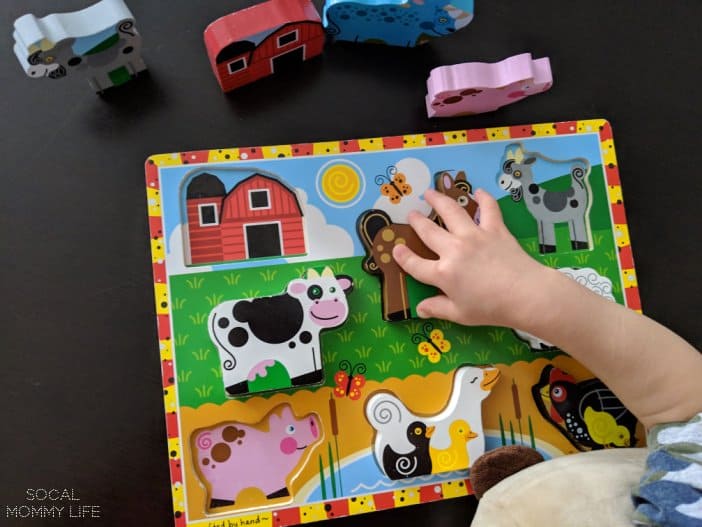
Reach up on a vertical surface
Standing in front of a mirror or window, have your child reach up to pull off removable stickers or suction balls.
Reach up to rub shaving cream over the surface, or tape a paper to the surface and apply dot paints or crayons.
Reaching up on a vertical surface works the upper muscle strength as well and grasp and wrist control.
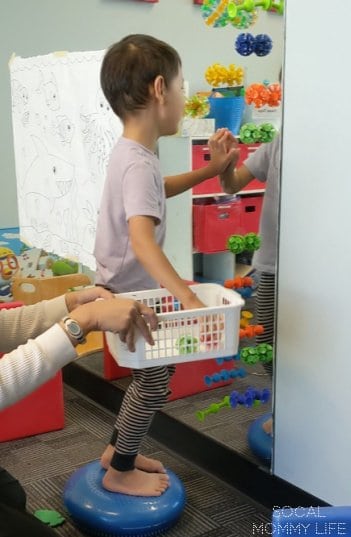
Playing drums
Bang hands (open hands) onto therapy ball, toy drum, table, or other surfaces to “make music.”
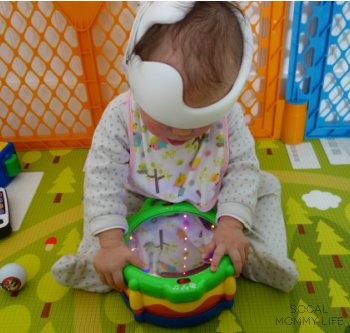
Banging will help your toddler strengthen his hand and wrists muscles. Alternating between both hands can also help with coordination.
Baby Will had a difficult time trying to play with his hands, but he loved seeing the lights from tapping on this drum. This music toy is particularly helpful for fine motor skills and Baby Will was able to develop those much faster than before!
Picking up small objects for a better pincer grasp
A pincer grasp is the ability to hold an object between the thumb and the index finger. This ability is an important milestone while your child uses her pincer grasp to pick things up and feed herself. It also lays the foundation for a good pencil grip when she starts school.
This skill usually develops between 9-10 months old, but will not be fully developed until your baby’s first birthday.
To encourage pincer grasp, have your child pick up small manipulative such as dried beans, dried corn, cheerios, beads, small rolled pieces of playdough. Always closely supervise when playing with small objects to avoid choking accidents.
Learn basic dressing skills
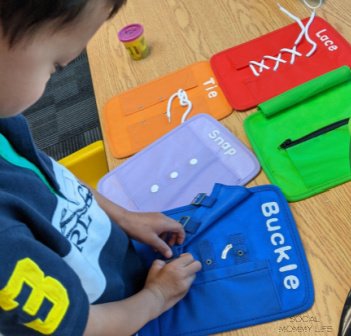
A great way to improve fine motor skills in toddlers is through dressing activities.
Through playing with a variety of learn-to-play practice boards, your toddler will learn how to dress and tie shoes.
A toddler usually doesn’t have the fine motor skills to tie, lace or buckle, but you can help your child get a head start by completing most of the steps but leave the final step for him to do.
For example, I lace up the string and ask Baby Will to string through the last hole. Or, I help connect the zipper and have my toddler pull it up himself.
Also, It’s easier to untie knots than it is to tie them so start by having your child practice unraveling.
Crumbling and tearing different textures of paper
Tearing various types of paper is an excellent way for young children to improve their bilateral coordination skills as well as mastery of dexterity.
These skills will help them learned how to use scissors, work independently and develop fine motor control – all things that will come in handy later during their school years.
Work on bilateral coordination by helping your child crumble or tear various types of paper that require different amounts of strength. Some ideas include tissue paper, wrapping paper, printer paper, and construction paper.
Container play
A great no-cost fine motor activity is to provide an array of plastic containers and utensils to your toddler. Help him practice stacking objects by putting them in the container, pressing or taking off lids, and pretend to stir with utensils.
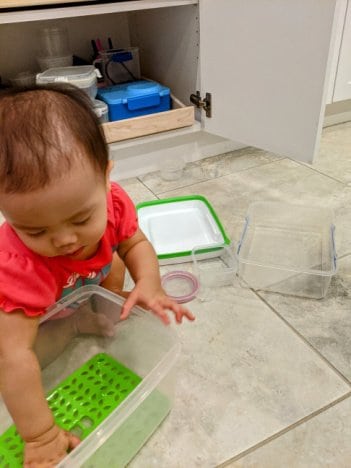
When I’m in the kitchen cooking, I let Baby Will (now Baby Madi as well) play with the Tupperware that is stored on the bottom shelf in the pantry. They can spend an entire hour playing with my plastic wares and I get to make dinner uninterrupted.
Talking about killing birds with one stone!
Play with sensory box
While filling a sensory box with rice or beans is a great idea, I’m all up for a no-mess sensory play with minimal clean-up.
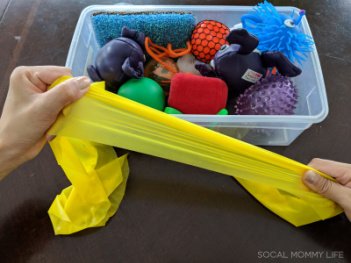
You can curate small objects such as spoons, sensory balls, cotton balls, kitchen sponges, scraps of sandpaper, squish balls, therapy band, or any fidget toys will do.
Ask your child to use the spoon to pick up small items. You can hold on to one end of the therapy band and ask your toddler to pull on the other end as hard as she can. Have her squish the squish ball between her palms, and stack two cotton balls on top of each other.
Play ideas with a sensory box are endless.
Final thoughts on fine motor toddler activities
It’s never too early to start encouraging your child’s fine motor development. Whether you’re just starting to teach them how to hold a crayon and draw, or if they’ve already mastered some of the basics, there are plenty of ways for parents to help their little ones develop these important skills at home.
We hope this blog post has given you an idea or two on how you can improve your toddler’s fine motor skills today!
Have any other tips that have helped your kids with their dexterity? Let us know in the comments below!
Fine motor toddler activities related articles
- Beginner’s Guide to Sensory Box For Toddlers
- KiwiCo koala crates review (2021) – Best subscription for toddler’s toys
- 7 Tips To Potty Train A Stubborn Child
10 Fine Motor Toddler Activities You Should Do at Home
Save these pins to your Pinterest board now ⬇️
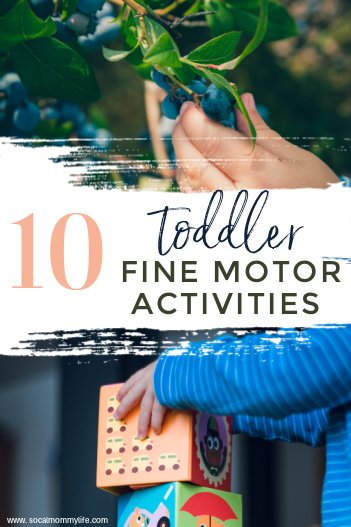

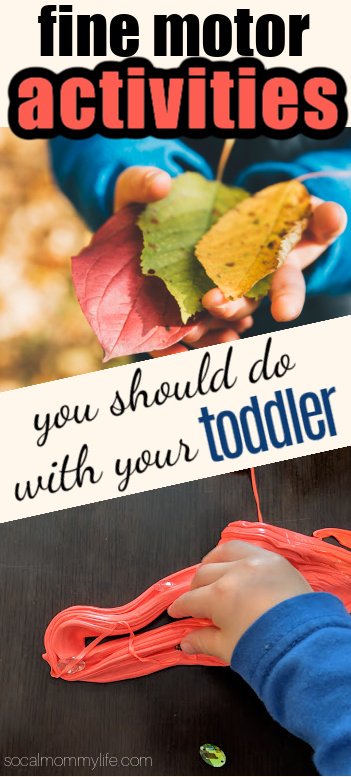



8 comments
Wow this is a thorough article! It’s amazing how increasing toddlers motor skills is connected to intelligence.
This is so helpful! I had no idea the reaching up was useful for fine motor skills development.
I have 3 cousins who are currently taking care of toddlers and I can’t wait to share this with them, I’m sure they’ll find this really helpful. Thank you so much x
I love this article! My son is 19 months old and will be trying some of these this weekend!
I’m an occupational therapist, and I love this post! Great info and ideas 🙂 well done!
I am a new mom and you gave a lot of informative details on motor skills. I never really thought to pay attention to some of this but after reading I know my baby girl seems to be on the right path. I like your idea of the play dough seems very helpful. Praying for you and your little one, blessings to you all!
these are all definitely fun activities as well that help develop skills without realizing it!
Love this article. My three year old is really into threading and sewing right now!